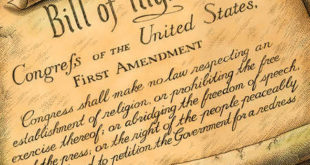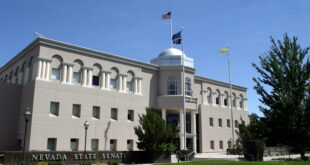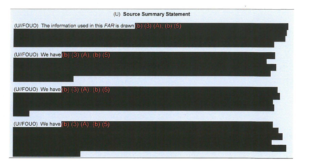The Nevada Broadcasters Association’s bill, SB218, is a real threat — to newspapers, of course, because it would remove public notices from them, but also to public notice in general.
The bill was heard Wednesday by the Senate Government Affairs Committee. Introduced by Sen. Aaron Ford, D- Las Vegas, it’s the third time a similar bill has been attempted by the broadcasters. The others were introduced in the Assembly in 2013 and 2015, and they didn’t advance. No vote was taken Wednesday.
Mary Beth Sewald, president and CEO of the broadcasters association, pitched the bill as an innovative and transparent way to publish notices — by placing them on broadcasters’ web sites, instead of in newspapers. It was described as a cost-saving measure for local governments, several of which lined up in support of the bill. The presentation was quite similar to the one she gave in 2015. I think it used the same video clip of a prototype web site, but I can’t be sure.
My testimony, along with Nevada Legal News publisher Scott Sibley, a former Assemblyman, represented the only opposition to the bill.
I’ll paste the gist of my testimony below (I veered from my prepared remarks at several points, so this isn’t exactly what I said.) I started by pointing out that everything the broadcasters were proposing to do, the newspapers already do — for free.
Nevada newspapers have long recognized the value in placing public notices online. That’s why we’ve been doing it for nearly seven years now, at no additional cost. People deserve as much notice as possible of this important information — which includes not just notice of government functions such as city ordinances, public bids, and zoning regulations, but also protections of your individual rights — termination of parental rights, summons in a civil lawsuit, notice to sell property to enforce a judgment.
This bill doesn’t help. In fact, I think it hurts. Notices now are published in qualifying newspapers in each county and on their web sites and on a statewide site operated by the Nevada Press Association, at no additional cost, at Publicnoticeads.com. In fact, that site contains a nationwide compilation of 47 states and the District of Columbia. That site has been in place since 2010. You can search by county and by newspaper for keywords. You can set up push notifications that will notify you by email when, for example, the word ‘foreclosure’ comes up.
At the larger papers, the notices are uploaded automatically every night to their websites and to the statewide site. The smaller papers do it manually, by saving the notices they are running that week and uploading them.
We also operate nevadapublicnotice.com, a landing page for notices, and most newspapers publish them on their own sites. For example, the Review-Journal has both RJLegalNotices.vegas and RJClassfieds.vegas. When you look for a notice, you know where to find it.
The key difference, though, is that the online notices are in addition to the print notices. Yes, you can search for them. But a primary function of public notices is that they are disseminated throughout community. They don’t just sit there for somebody to find.
I’ve been searching for an analogy, and there’s one in this building. You don’t make people choose between a printed version of a bill and the version on NELIS. You make both available.
Many people use the terms ‘public notices’ and ‘legal notices’ interchangeably, but there are different types scattered throughout NRS. ‘Legal’ notices can affect people’s individual property or rights.
With newspaper notice, clerks at the papers issue a notarized affidavit of publication, accompanied by a copy of the notice itself, which can be used in court to verify its true and accurate publication. This is the means to validate due process and is a crucial part of the notice process. (See the statement from the Public Notice Resource Center.)
There is no court standard for public notices posted solely on internet websites.
This attempt to shift public-notices to broadcasters would hurt the people who rely on Nevada’s small-town papers the most. These are places where internet service is spotty, at best, and where readership remains high, especially among older readers in rural areas. These are the county seats.
The broadcasters association may tell you this offers a choice — but the choice is available only to the government: to choose whether to put a notice in print and online, or whether to put it online only. That takes away the choice for residents and citizens of how they want to read their notices.
Keep in mind, also, that the newspapers made a major concession in 2015 when we agreed not to fight a bill that dropped assessor rolls from publication. It was a long time coming, and it made sense in the larger counties. But the smaller communities felt the most pain, like Carson City and Elko, just as they were coming out of the recession and starting to add back jobs.
Finally, I want to point to recent studies in three states —Texas, Wisconsin and Kentucky — when their legislatures faced similar questions of shifting to internet notices. All three states concluded that print notices should be maintained. I’m happy to provide those reports to you to learn why the legislators in those states arrived at their conclusions.
If I may, I would like to go into some specific problems in the bill:
Section 3: Definition of “broadcaster” includes any broadcaster anywhere. I’ve explained before how Clark County could begin posting notices on the website of the radio station in Elko. But the language of this bill would allow them to post the notices on the website of a radio station in Minnesota or Massachusetts.
Also, lots of people hold broadcast licenses. One example would be the Brewery Arts Center, here in Carson City, which holds a license for low-power broadcasts. This bill would make the Brewery Arts Center’s website eligible to run public notices from anywhere in the state.
Section 9: “any federal statute or regulation.” This is a direct conflict of interest for broadcasters, as they are required by the Federal Communications Commission, 47 CFR Section 73.3580, to publish notice in a local newspaper whenever there’s a change in their license.
Also, it permits publication of notices on broadcaster websites, or a broadcaster association, but doesn’t include newspaper websites or the Press Association.
Section 11 (a): It should be “and” — publication both in print and on a website. And again, if it can be published on a broadcaster website, then it could be published on a newspaper website, or the Press Association’s site, where we have been compiling them for the last half-dozen years.
Also, same problem in Section 11 paragraphs 3, 4(b) and 6.
Section 12: The Postal Service has changed the name of the permit to ‘Periodicals,’ instead of second-class That’s never been cleaned up in NRS. To make clear: Not all newspapers are eligible to publish notices. They must hold that mailing permit.
Section 13: Same as other sections, where it refers to the websites of broadcasters and a broadcaster association but not to the websites of newspapers and the Press Association.
Section 14: Same as above.
Section 15: newspaper or website. Also, newspapers and the Press Association.
Section 15, paragraph 2: Type size. It specifies the newspaper type, but not a website type size.
Section 15, paragraph 3: Again, doesn’t include newspaper websites or the Press Association website. It requires bids for all government public notices. Also, I’m not sure what is intended by the language allowing government entities to “reject any or all proposals.” They can’t reject all proposals, because they have to publish the notice somewhere.
Section 16: Same as above.
 Nevada Press Association The best in Nevada journalism since 1924
Nevada Press Association The best in Nevada journalism since 1924



